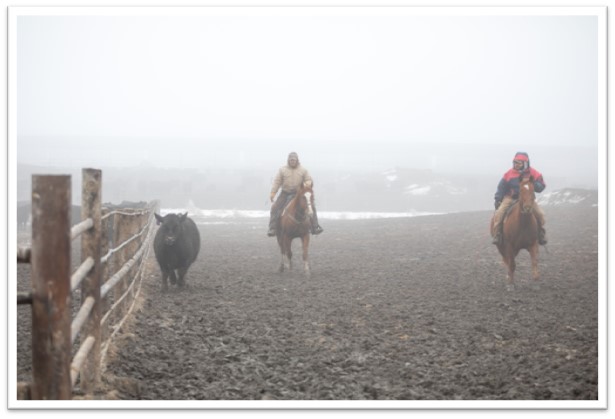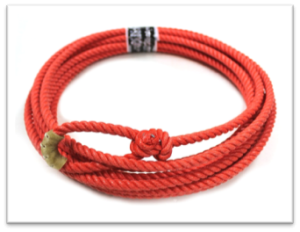1.6 Moving Cattle
Moving Cattle – Shipping and Riding Pens

Unique Working Environments
- Surfaces: Everything is hard when you land, even in mud.
- Weather: Cattle have to be cared for, no matter the weather.
Everything can become slick either by icy conditions, manure, urine and mud. Mounds shouldn’t be crossed on horseback when they are slick. Concrete can also be slick. Use caution when riding on feed pads or any other concrete surface.
Horses can lose their footing on hard or muddy surfaces. Use proper horseshoes for the weather conditions. Take it slow and let the horse think his way through dangerous situations.
- Ensure all gates are prepared.
- Walk the route before moving the livestock and look for anything they could spook or startle the livestock. Squeaky gates can startle livestock and the same for shadows.
- Inform all parties that livestock are being moved and stop all movement of machinery and truck or loud noises.
Attitude and Emotions
Livestock can easily detect your mood and will act accordingly. So be cool calm and collective. Talk in a calm tone when approaching and moving them. Becoming angry at your horse and cattle can cause situations to become even more dangerous.
- The main defense of cattle is to run away. But if pressured too much they may turn and will run through you and your horse.
- Horses pushed into dangerous situations may react violently. Know your horse and know when to quit.
- Change horses when your horse is tired or acting up.
- If someone tells you to get off a horse and get another, do so.
- If a horse is too much for you to handle, get another.
- Not every person gets along with every horse.
Remember that if a horse ends up in a bunk, there is a likelihood that you may be under it.
Moving Cattle – Shipping
Flow of Cattle
It is important to plan and understand the flow of cattle. One very important condition is known as “blowbacks”. This is when cattle come back toward the horse and rider. This can be one of the most dangerous situations on the feedyard. The horse and rider can be knocked down, trampled, or pushed into the bunk.
Several things can cause blowbacks including:
- Riders getting too close to the cattle while moving.
- Animals being pushed too quickly.
- Too much pressure being applied to the animals.
- Gates in front of the animals not opened properly.
- Cattle frightened by something in front of them.
Being knocked down is more likely to happen if the horse and rider are standing sideways. If being charged by animals – turn your horse with its tail to the cattle protecting the chest and front legs of the horse.
- Practice low-stress handling methods. Understanding the flight zone and pressure points of the livestock, the give and release method works very well.
- Move smaller groups.
- Communication! Make sure everyone in the area knows the plan for moving. This will ensure gates are open and distractions are minimal.
- Open two gates if needed to relieve pressure.
- When the cattle are moving leave them alone and do not exert constant pressure.
“Low-stress cattle handling is easier and safer for people, induces less cattle stress and injury, and produces a better product with a better public image.” (Ben Bartlett Beef Extension MSU)
Moving Cattle – Ropes

Use of ropes is seen in many feedyards as a last resort. Some yards have ropes placed throughout the yard in strategic places.
What is your feedyard’s policy on using ropes? Discuss possible risks of using ropes and experiences that pen riders have had on your feedyard.
Horse and Rider Safety
- Pay attention and don’t get your horse in a bind. Always have a route of escape whenever you ride into a pen or are moving cattle.
- NO RACING HORSES back to the barn or horseplay. There is a possibility of having a wreck with a feed truck. It is also possible the horse could break bones in its lower leg.
- Yield right of way to all vehicles when not pushing cattle.
- Pay attention to the skies, if you hear thunder or see lightening, head for shelter. Weather conditions can also affect the livestock behavior. For example, if it is too hot, they can get short tempered. Similarly, thunder and lightning can scare them.
- Take action when there is:
- Mud, snow and ice – Change horseshoes and change boot types.
- Lightning – GET OUT OF THE YARD! You may be the highest point.
- Severe heat and cold – Take care of yourself and your horse with extra water and warmth.
- If cattle are acting aggressively, do not put you or your horse up against an aggressive animal. Instead, get assistance.
If conditions are too dangerous to ride a horse, you may have to get off and walk your horse.
Review
Work through these interactive questions to review the important concepts discussed.
